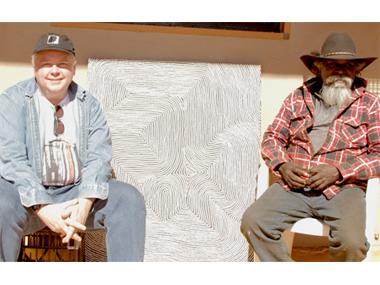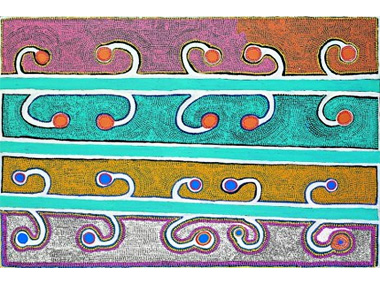SCHOLL SEEKS THE HOLY GRAIL

Dennis Scholl (l) and Warlimpirrnga Tjapaltjarri catch up in Kiwirrkurra as the collector pursues Aboriginal art
Posted by Jeremy Eccles | 20.01.15
Dates:
13.02.15
: 03.05.15
If only more art collectors around the world today could open their eyes and admit, “We'd grown a little tired of the cult of personality and money that the contemporary art world has become, so were looking to re-energise”. They might then see (and buy) Australian Aboriginal art.
The American couple who did – Dennis and Debra Scholl – tried pretty hard to ignore it. They'd been collecting and commissioning non-Indigenous art since 1978, developed their own showcase in Miami called World Class Boxing (after the previous occupants of the building) for a collection which had grown into the thousands by buying one work every 10 days over some 37 years, and they'd employed serious curators to mould exhibitions and write catalogues.
But they'd only seen the tourist side of Aboriginal art before on visits to Australia connected to Dennis's delight in the grenache grape. It was almost unknown in America before he encountered it in the Barossa. But he was pretty unexcited by the tourist art. Then, challenged by me in 2008 to see some serious stuff and look at it as abstraction, he had a Damascene conversion. “I had my epiphany moment in the basement galleries of the Art Gallery of NSW”, he told me on a buying trip last year in Darwin. "But discovering Tjumpo Tjampitjinpa and Alma Webou in Sydney convinced me to head home and tell Debra (who has one of the two votes needed to buy anything), 'You won't believe what we're going to do next!'”.
Three hundred and twenty canvases later, it's time to show the US contemporary art world the new black.
And it's considered the Holy Grail of Aboriginal art – persuading the world that the work of artists operating in the “oldest continuous tradition of visual art on earth” (Robert Hughes, Time 1988) is also as contemporary as John Olsen or Joel Holmberg. Too often, noses are turned up and the word 'ethnographic' gets attached to even the most recent canvases or barks that have come from the deserts, The Kimberley and Arnhemland. For there is also a reluctance to use art-words like Abstract or Expressionist about work that may look like one of those Western art categories but may actually be portraying a map of Country, secret/sacred information or ancestral stories.
Dennis Scholl has none of that reluctance. And he's used his reputation to persuade some of the best US contemporary art museums to make their walls available for 75 artworks by the nine male artists who caught the Scholl's eyes. Each has contributed 8 or 9 works to the collection – some bought online, but only after they'd found the canvas that inspired them. Tjumpo from Balgo started the flow, but Butcher Cherel, Ngarra, Paddy Bedford, Boxer Milner and Billy Thomas - all Kimberley men - followed, then Warlimpirrnga Tjapaltjarri ('Last of the Nomads') and Tommy Mitchell from the deserts, and the one-off Prince of Wales from Darwin. They're pursuing women artists now.
The Scholls had seen survey shows of Aboriginal art in the US such as the Kaplan/Levi collection in Seattle, sitting and watching the crowds and observing “so many spiritual moments amongst viewers, we were gob-smacked. But that show told stories. We're different; we're showing the abstract work of artists who are simply some of the best at it in the world. And it's an abstraction that moves in a profoundly spiritual way, capturing the elemental power of the landscape and the Dreaming”.
But how had the Scholls persuaded museums of the calibre of the new Perez Museum in Miami, the Charles H Wright in Detroit (“the largest Afro-American museum in the country”), and the Portland Institute of Contemporary Art to take their show? After all, former Australian National Gallery Director Brian Kennedy had failed to woo any museum in the country to take a show he was trying to tour in 2007. “I do have a lot of relationships”, was the cool response, “I picked wisely, and, as with my experience of bringing Barossa Grenache wine into the US, I believed in the product; they're both incredibly compelling”.
Most compelling of all, perhaps was Scholl persuading Jens Hoffman, world biennial curator and Deputy Director of the Jewish Museum in New York, to write an essay for the catalogue contextualising art by old, dusty and mostly now-dead Aboriginal men with that of the hottest of current New York painters.
The 'No Boundaries' tour kicks off in Nevada next month. Not only does the Nevada Museum of Art (in Reno) have a special department concerning the environment run by William Fox who encouraged the Scholls to open their show there, but during the last three years they've been working with Aboriginal artists who live in the remote Paruku/Lake Gregory region of Western Australia on a pioneering art & science project led by non-Indigenous painters Mandy Martin and Kim Mahood and conservationist/station owner, Guy Fitzhardinge. The paintings and materials generated by both the Aboriginal and kartiya artists were donated to the Center for Art + Environment's Archive Collections in 2013 and exhibited in mid-2014.
The 'No Boundaries' tour ends at the Perez in Miami, coinciding with the 2015 Art Basel Miami Beach.
Share this:
»  del.icio.us
»
del.icio.us
»  Digg it
»
Digg it
»  reddit
»
reddit
»  Google
»
Google
»  StumbleUpon
»
StumbleUpon
»  Technorati
»
Technorati
»  Facebook
Facebook
Contact Details

The painting that opened Scholl's eyes - Tjumpo Tjapanangka's 'Wiringurru', 1998. Synthetic polymer paint on canvas, 120 x 80 cm.

Boxer Milner Tjampitjin, 'Oolaign', 2000. Synthetic polymer paint on canvas - 150 x 100 cms.
Further Research
Artists: Alma Webou | Billy Thomas | Boxer Milner | Butcher Cherel | Ngarra | Paddy Bedford | Prince Of Wales | Tjumpo Tjapanangka | Tommy Mitchell | Warlimpirrnga Tjapaltjarri
News Tags: Debra Scholl | Dennis Scholl | Jeremy Eccles | Nevada Museum of Art | No Boundaries Tour
News Categories: Blog | Exhibition | Feature | Industry | News | North America
Exhibition Archive
- 10.10.17 | TARNANTHI 2017
- 11.08.17 | Natsiaas 2017
- 20.07.17 | APY ART DOMINATES THE WYNNE
- 17.07.17 | Anangu Artist Wins $100,000 Prize
- 14.07.17 | The End of AAMU
- 11.07.17 | ART ACROSS THE COUNTRY
- 11.07.17 | TARNANTHI IN OCTOBER
- 05.07.17 | TJUNGUṈUTJA - from having come together
- 13.06.17 | Ghost-Nets Straddle the World
- 07.06.17 | Grayson Perry Going Indigenous?
- 05.06.17 | Barks Bigger than Ben Hur
- 27.05.17 | NGA QUINQUENNIAL 2017
- 21.05.17 | Blak Douglas Finds Home at the NGA
- 21.05.17 | BRIAN ROBINSON WINS HAZELHURST WOP
- 18.05.17 | PARRTJIMA 2.0
Advertising

